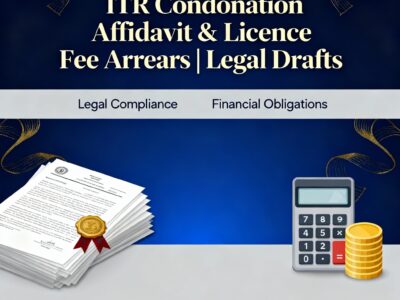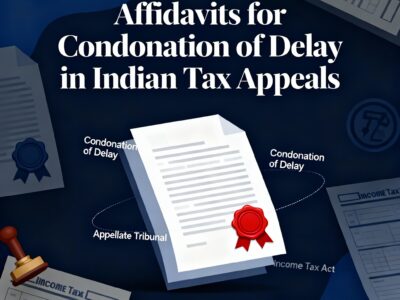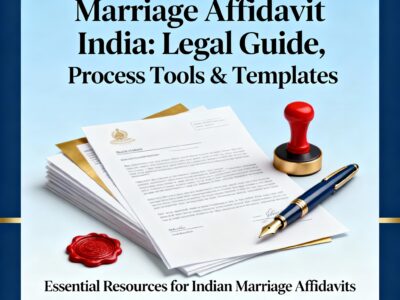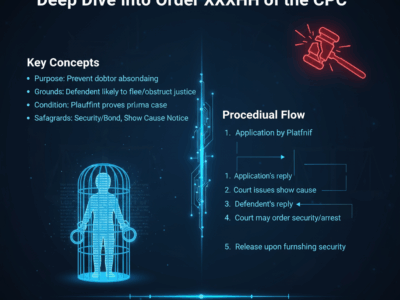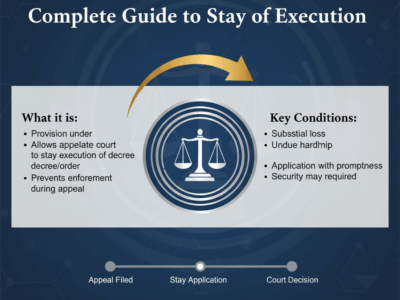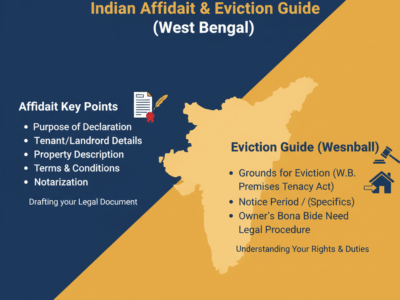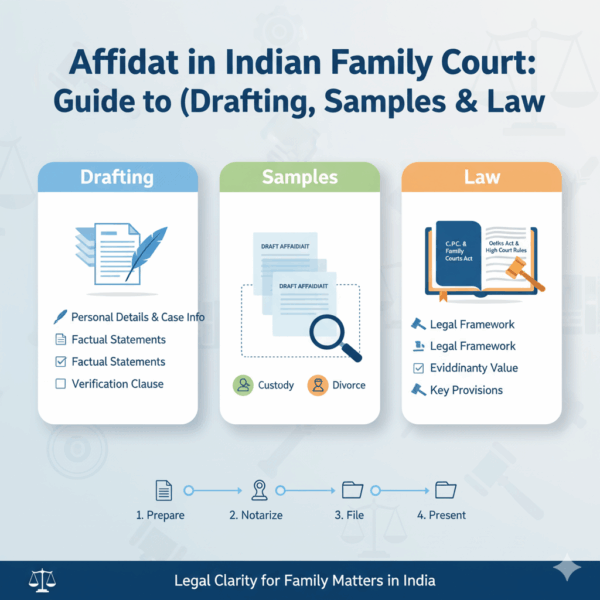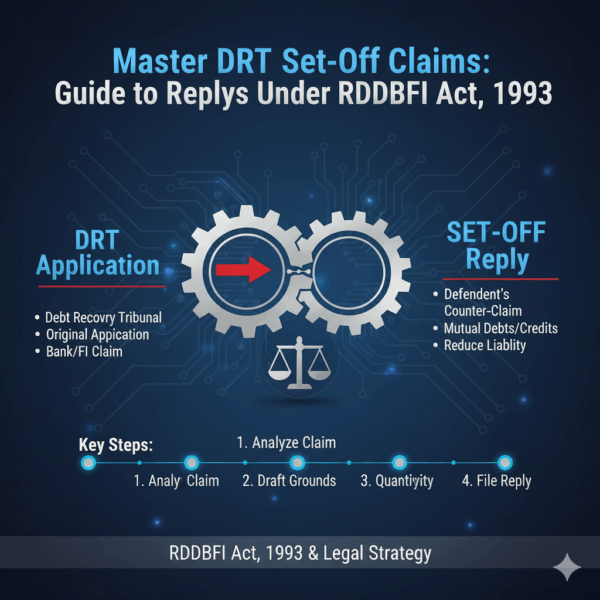Writ Miscellaneous Petition & Affidavit: Indian High Court Guide (Sec 151 CPC)
Navigating the procedural complexities of the Indian legal system requires a firm grasp of interlocutory applications. Among the most crucial tools in a litigant’s arsenal is the Writ Miscellaneous Petition, an application filed within a pending writ case to seek interim relief or procedural directions from the High Court. This petition, often supported by a sworn Affidavit and grounded in the inherent powers of the court under Section 151 of the Code of Civil Procedure (CPC), can significantly influence the trajectory of a case.
This comprehensive guide for 2025 demystifies the entire process. From understanding the doctrinal basis of Section 151 CPC to mastering the art of drafting, we provide a step-by-step walkthrough. You will find annotated sample formats, a detailed procedural analysis based on the Calcutta High Court rules (WPO & WPA), strategic advice for both petitioners and respondents, and answers to frequently asked questions, making this your definitive resource for drafting effective Writ Miscellaneous Petitions and supporting Affidavits in India.
A Comprehensive Guide to Drafting a Writ Miscellaneous Petition and Supporting Affidavit in Indian High Courts
Authored by the Evaakil.com Legal Research Team
Part I: The Inherent Powers of the High Court & Section 151 CPC
Section 151 of the Code of Civil Procedure, 1908 (CPC) is a pivotal provision that codifies the doctrine of the inherent powers of a civil court. It doesn't confer new jurisdiction but preserves the court's discretionary power to ensure justice is served.
The Dual Pillars of Section 151 CPC
Ends of Justice
To make orders necessary to secure fair and just outcomes.
Prevent Abuse of Process
To stop the misuse of court procedures for unjust ends.
Doctrinal Foundation: Landmark Judgments
The Supreme Court of India has, through various pronouncements, clarified the contours of Section 151. These judgments establish that the power is to be used sparingly and only when there is a gross failure of justice.
- Manohar Lal Chopra v. Rai Bahadur Rao Raja Seth Hiralal (AIR 1962 SC 527): The Court held that inherent powers are not to be exercised when there is a specific provision in the CPC to deal with the matter. It is a power to supplement, not supplant, the code.
- Ram Chand and Sons Sugar Mills Pvt. Ltd. v. Kanhayalal Bhargava (AIR 1966 SC 1899): It was reiterated that inherent jurisdiction must be exercised *ex debito justitiae* (as a matter of right to justice) but only in rare cases where the court must act to prevent injustice.
Scope and Limitations
While wide, the court's inherent power is not unfettered. It is a residual power subject to well-defined limitations to prevent arbitrary use.
Permissible Usage
- When no express remedy exists in the CPC.
- To rectify the court's own procedural errors.
- To prevent a manifest injustice (*ex debito justitiae*).
Strict Limitations
- Cannot conflict with express statutory provisions.
- Cannot be used to override the Limitation Act.
- Must be exercised with caution and judicial discretion.
Part II: Common Scenarios for Filing a Miscellaneous Petition
A Writ Miscellaneous Petition (W.P.M.P.) or a Civil Application (CAN) is not a standalone remedy but an ancillary application filed within a pending writ petition. It is used to seek interim relief or procedural directions from the court. Here are some common instances:
Seeking an Injunction or Stay
To stay the operation of an impugned government order, notice, or administrative action until the main writ petition is decided.
Bringing Subsequent Events on Record
To inform the court of new developments that occurred after the writ petition was filed and which have a direct bearing on the case.
Production of Additional Documents
The focus of this guide. Used to file newly discovered evidence that is crucial for the fair adjudication of the matter.
Amendment of Pleadings
To correct typographical errors, add necessary parties, or modify the prayer of the main writ petition based on new information.
Part III: Annotated Format of the Writ Miscellaneous Petition
The structure of a miscellaneous petition is crucial. It must establish the applicant's standing, state the context, present a clear cause of action, and conclude with a specific prayer. Below is a breakdown of the key components.
Grounds: The Triad of Justification
This is the most critical part of the application. The petitioner must convincingly argue three points: the relevance of the new documents, the due diligence exercised, and why the balance of convenience favors their admission.
The Three Pillars of Your Argument
-
Relevance & Materiality: Argue why the documents are vital and directly impact the core issues of the case.
-
Due Diligence & Delay: Explain why the documents couldn't be filed earlier, proving the delay was unintentional.
-
Prejudice & Balance of Convenience: Show that allowing the documents causes no harm to the respondent but prevents irreparable injury to the petitioner.
Common Drafting Pitfalls
- Vague Prayers: Avoid prayers like "pass any other order." Be specific about the relief you are seeking from the court.
- Insufficient Justification for Delay: A mere statement like "the document was not available" is weak. Provide a detailed, credible narrative.
- Failing to Link to Main Petition: Clearly state which paragraph or ground in the main writ petition the new document supports.
Part IV: Annotated Format of the Supporting Affidavit
An affidavit provides the evidentiary foundation for the facts asserted in the petition. It transforms the application's claims into sworn testimony, making the deponent accountable for their truthfulness under penalty of perjury.
The Legal Sanctity of an Affidavit
An affidavit is not a mere formality. Under Section 191 of the Indian Penal Code, 1860, giving false evidence under oath is a punishable offense. The verification clause at the end of the affidavit is critical, as it specifies which statements are based on the deponent's personal knowledge and which are based on information and belief.
Anatomy of a Supporting Affidavit
Cause Title
Deponent's Declaration
Sworn Statements
Verification Clause
Part V: Responding to a Miscellaneous Petition: The Respondent's Playbook
When served with a miscellaneous application, the respondent has the right to file an "Affidavit-in-Opposition" to counter the petitioner's claims. A strong opposition focuses on procedural lapses and substantive weaknesses in the petitioner's application.
Key Grounds for Opposition
Laches and Inordinate Delay
Argue that the petitioner has been negligent and has approached the court after an unreasonable delay. This is a powerful equitable argument against granting relief.
Lack of Materiality
Demonstrate that the "new" documents are irrelevant to the core issues of the writ petition and would not change the outcome of the case.
Prejudice to the Respondent
Show that allowing the application at a late stage would cause irreparable harm, such as prolonging the litigation or forcing a re-examination of witnesses.
Suppression of Material Facts
If the petitioner has intentionally concealed information from the court, it can be a ground for dismissing the application outright (*suppressio veri, suggestio falsi*).
Part VI: Procedural Adherence: Calcutta High Court Case Study
The Calcutta High Court maintains a unique distinction between its Original Side and Appellate Side jurisdictions. This distinction is crucial as it determines which set of procedural rules applies to the filing, numbering, and listing of a writ petition.
Procedural Checklist & Comparison
| Feature/Step | Original Side Rule/Practice | Appellate Side Rule/Practice |
|---|---|---|
| Jurisdiction Heading | Constitutional Writ Jurisdiction (Original Side) |
Not Applicable |
| Jurisdiction Heading | Not Applicable | Constitutional Writ Jurisdiction (Appellate Side) |
| Main Case Type Code | WPO (Writ Petition) |
Not Applicable |
| Main Case Type Code | Not Applicable | WPA (Writ Petition) |
| Interlocutory App. Code | Often GA (General Application) |
Not Applicable |
| Interlocutory App. Code | Not Applicable | CAN (Civil Application) |
| Annexure Marking | P/1, R-1/1, etc. (as per Rule 21) |
P/1, R-1/1, etc. (as per Rule 21) |
| Affirmation of Affidavit | Before Notary / Oath Commissioner | Before Notary / Oath Commissioner (Appellate Side) |
| Returnable Date of Rule | Typically 3 weeks (unless otherwise ordered) | Not Applicable |
| Returnable Date of Rule | Not Applicable | Typically 8 weeks (unless otherwise ordered) |
| Mandatory Declaration | Required as per Rule 11 (No prior application filed) | Required as per Rule 11 (No prior application filed) |
Part VII: Strategic Drafting and Best Practices
Effective legal drafting anticipates and neutralizes potential objections. When drafting the grounds, specificity is paramount. The application should be framed not as an admission of an earlier mistake, but as a proactive measure to assist the court.
Summary of Best Practices
- Clarity and Brevity: Be concise, focused, and free of unnecessary jargon.
- Specificity: Ensure descriptions, grounds, and prayers are unambiguous.
- Procedural Compliance: Meticulously adhere to relevant High Court rules.
- Honesty and Bona Fides: Be truthful in explaining delays or discoveries.
- The Affidavit is Key: Treat the affidavit as the evidentiary pillar of your application.
Part VIII: The Court's Discretion and Potential Outcomes
The final decision on a miscellaneous application rests entirely on the discretion of the court. The judge will weigh the arguments from both sides and consider the overall interest of justice.
Lifecycle of a Miscellaneous Petition
Step 1: Drafting & Filing
Petitioner files the Misc. Petition with a supporting affidavit.
Step 2: Service of Copy
A copy is served to the respondent's advocate.
Step 3: Opposition (Optional)
Respondent may file an Affidavit-in-Opposition.
Step 4: Hearing
Both sides present oral arguments before the judge.
Outcome A: Allowed
The prayer is granted. Documents are taken on record.
Outcome B: Dismissed
The application is rejected. Costs may be imposed.
Outcome C: Allowed with Costs
Prayer granted, but the petitioner must pay a penalty for the delay.
The Role of Costs
Courts often use the imposition of costs as a tool to balance justice. If an application has merit but was filed late due to some negligence, the court might allow it but order the petitioner to pay a monetary cost to the respondent to compensate for the inconvenience and delay. Conversely, if an application is found to be frivolous or an abuse of process, it will be dismissed with exemplary costs.
Part IX: Advanced Topics and Nuances
Distinction: Miscellaneous Application vs. Review Petition
It is crucial not to confuse a miscellaneous application under Section 151 with a Review Petition under Section 114 and Order XLVII of the CPC. The grounds and scope are fundamentally different.
| Basis | Miscellaneous Application (S. 151 CPC) | Review Petition (S. 114 CPC) |
|---|---|---|
| Objective | To seek interim orders or procedural directions. Does not decide the main issue. | To request the court to reconsider and alter its own final judgment. |
| Grounds | Based on the need for justice, preventing abuse of process, or managing litigation. | Strictly limited to: (i) discovery of new, important evidence; (ii) error apparent on the face of the record; or (iii) "any other sufficient reason." |
| Timing | Filed during the pendency of the main case. | Filed after the final order or judgment has been passed. |
The Doctrine of 'Abuse of Process'
Abuse of the process of court refers to the malicious and improper use of legal proceedings to obtain an unfair advantage. Examples include filing multiple litigations on the same subject matter or initiating proceedings with an ulterior motive. Section 151 acts as a shield, empowering the court to dismiss such applications and impose costs to deter such behavior.
Part X: Sample Legal Format (Illustrative Draft)
The following formats are illustrative and should be adapted based on the specific facts of the case and the rules of the concerned High Court. This sample is modeled on practice at the Calcutta High Court.
1. Memorandum of Writ Miscellaneous Petition (Under Section 151 CPC)
This is the main application. It is a formal request to the court for a specific interim order (like accepting new documents) pending the final disposal of the main writ petition. It briefly states the reasons, referencing the detailed explanation in the accompanying affidavit.
IN THE HIGH COURT AT CALCUTTA
Constitutional Writ Jurisdiction
(Original Side / Appellate Side)
W.P.M.P. No. ________ of 2025
(In W.P. No. _________ of 2025)
IN THE MATTER OF:
[Petitioner Name & Ors.]
... Petitioner(s)
- Versus -
[Respondent Name & Ors.]
... Respondent(s)
MEMORANDUM OF WRIT MISCELLANEOUS PETITION
(Under Section 151 of the Code of Civil Procedure, 1908)
For the reasons stated in the accompanying affidavit, the petitioner herein humbly prays that this Hon'ble Court may be pleased to:
a) Grant leave to the petitioner to file the additional documents annexed herewith as Annexure "P-[Next Number]".
b) Suspend the operation of the impugned order dated [Date of Order] issued by the Respondent No. [Number], pending the final disposal of the main writ petition.
c) Pass such other or further order or orders as this Hon'ble Court may deem fit and proper in the interest of justice.
And for this act of kindness, your petitioner as in duty bound shall ever pray.
Place: Kolkata
Dated: [Date] (Advocate for Petitioner)
2. Supporting Affidavit
This is the sworn statement of the petitioner (or an authorized person) that contains the factual basis for the miscellaneous petition. Every claim made in the petition must be substantiated by a statement in this affidavit. It must be formally sworn before a Notary Public or an Oath Commissioner.
IN THE HIGH COURT AT CALCUTTA
Constitutional Writ Jurisdiction
(Original Side / Appellate Side)
W.P.M.P. No. ________ of 2025
(In W.P. No. _________ of 2025)
IN THE MATTER OF:
[Petitioner Name & Ors.]
... Petitioner(s)
- Versus -
[Respondent Name & Ors.]
... Respondent(s)
AFFIDAVIT ON BEHALF OF THE PETITIONER
I, [Deponent's Full Name], son of [Father's Name], aged about [Age] years, by faith [Religion], by occupation [Occupation], residing at [Full Address], do hereby solemnly affirm and state as follows:
1. That I am the petitioner herein and as such I am well acquainted with the facts and circumstances of this case. I am competent to affirm this affidavit.
2. That the instant writ petition has been filed challenging the order dated [Date] passed by the Respondent No. [Number]. The said writ petition is pending for adjudication before this Hon'ble Court.
3. That subsequent to the filing of the writ petition, I have discovered certain documents which are crucial for the just adjudication of this case. A true copy of the said document is annexed hereto and marked as Annexure "P-[Next Number]".
4. That the said document could not be filed earlier despite due diligence because [Provide a clear and honest reason, e.g., "it was not in my possession and was located only on (Date) after a thorough search of old family records."]. The delay in filing the same is bona fide and unintentional.
5. That the statements made in paragraphs 1 to 3 are true to my knowledge, and the statements made in paragraph 4 are based on information received and believed to be true.
__________________
Deponent
Identified by me,
__________________
(Advocate for Petitioner)
Solemnly affirmed before me on this [Day] day of [Month], 2025.
__________________
(Notary / Oath Commissioner)
Part XI: Frequently Asked Questions (FAQ)
Can I file a miscellaneous petition after the final judgment?
Generally, no. A miscellaneous petition under Section 151 CPC is for interim orders during the pendency of a case. After a final judgment, your remedies would typically be an Appeal, a Review Petition, or a Curative Petition, each with its own specific grounds and limitations.
What if the other side does not accept a copy of my application?
If the advocate for the respondent refuses service, you must file an affidavit of service with the court, detailing the attempt and refusal. This proves to the court that you have complied with your duty to notify the other party, and the court can then proceed with the hearing.
Is there a time limit to file an Affidavit-in-Opposition?
The court usually specifies a deadline for filing an opposition when the matter is first heard. If no time is specified, it should be filed as soon as possible, and definitely before the next date of hearing. If you need more time, you must make a formal request to the court for an extension.

